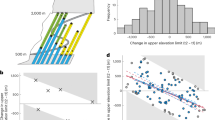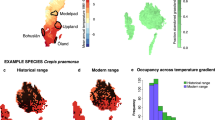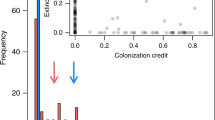Abstract
Climate change is expected to trigger an upward expansion of plants in mountain regions1,2 and, although there is strong evidence that many native species have already shifted their distributions to higher elevations1,3,4,5,6, little is known regarding how fast non-native species might respond to climate change. By analysing 131,394 occurrence records of 1,334 plant species collected over 20 years in the European Alps, we found that non-natives are spreading upwards approximately twice as fast as natives. Whereas the spread of natives was enhanced by traits favouring longer dispersal distances, this was not the case for non-natives. This was due to the non-native species pool already being strongly biased towards species that had traits facilitating spread. A large proportion of native and non-native species seemed to be able to spread upwards faster than the current velocity of climate change. In particular, long-distance dispersal events and proximity to roads proved to be key drivers for the observed rapid spread. Our findings highlight that invasions by non-native species into native alpine communities are a potentially significant additional pressure on these vulnerable ecosystems that are already likely to suffer dramatic vegetation changes with ongoing warming and increasing human activity in mountain regions.
This is a preview of subscription content, access via your institution
Access options
Access Nature and 54 other Nature Portfolio journals
Get Nature+, our best-value online-access subscription
$29.99 / 30 days
cancel any time
Subscribe to this journal
Receive 12 print issues and online access
$209.00 per year
only $17.42 per issue
Buy this article
- Purchase on Springer Link
- Instant access to full article PDF
Prices may be subject to local taxes which are calculated during checkout



Similar content being viewed by others
References
Grabherr, G., Gottfried, M. & Pauli, H. Climate effects on mountain plants. Nature 369, 448 (1994).
Walther, G. et al. Ecological responses to recent climate change. Nature 416, 389–395 (2002).
Lenoir, J., Gégout, J. C., Marquet, P. A., de Ruffray, P. & Brisse, H. A significant upward shift in plant species optimum elevation during the 20th century. Science 320, 1768–1771 (2008).
Chen, I., Hill, J. K., Ohlemüller, R., Roy, D. B. & Thomas, C. D. Rapid range shifts of species associated with high levels of climate warming. Science 333, 1024–1026 (2011).
Gottfried, M. et al. Continent-wide response of mountain vegetation to climate change. Nat. Clim. Change 2, 111–115 (2012).
Morueta-Holme, N. et al. Strong upslope shifts in Chimborazo’s vegetation over two centuries since Humboldt. Proc. Natl Acad. Sci. USA 112, 1274–12745 (2015).
Pauchard, A. et al. Ain’t no mountain high enough: plant invasions reaching new elevations. Front. Ecol. Environ. 7, 479–486 (2009).
Alexander, J. M. et al. Assembly of nonnative floras along elevational gradients explained by directional ecological filtering. Proc. Natl Acad. Sci. USA 108, 656–661 (2011).
Pyšek, P., Jarošík, V., Pergl, J. & Wild, J. Colonization of high altitudes by alien plants over the last two centuries. Proc. Natl Acad. Sci. USA 108, 439–440 (2011).
van Kleunen, M. et al. Global exchange and accumulation of non-native plants. Nature 525, 100–103 (2015).
Marini, L. et al. β-diversity patterns elucidate mechanisms of alien plant invasion in mountains. Glob. Ecol. Biogeogr. 22, 450–460 (2013).
Corlett, R. T. & Westcott, D. Will plant movements keep up with climate change? Trends Ecol. Evol. 28, 482–488 (2013).
Hulme, P. E. Alien plants confront expectations of climate change impacts. Trends Plant Sci. 19, 547–549 (2014).
Liu, Y. et al. Do invasive alien plants benefit more from global environmental change than native plants? Glob. Change Biol. http://dx.doi.org/10.1111/gcb.13579 (2017).
van Kleunen, M., Weber, E. & Fischer, M. A meta-analysis of trait differences between invasive and non-invasive plant species. Ecol. Lett. 13, 235–245 (2010).
Alexander, J. M., Naylor, B., Poll, M., Edwards, P. J. & Dietz, H. Plant invasions along mountain roads: the altitudinal amplitude of alien Asteraceae forbs in their native and introduced ranges. Ecography 32, 334–344 (2009).
Sorte, C. J. B. et al. Poised to prosper? A cross-system comparison of climate change effects on native and non-native species performance. Ecol. Lett. 16, 261–270 (2013).
Prosser, F., Bertolli, A. & Festi, F. Flora Illustrata del Monte Baldo (Edizioni Osiride, 2009).
Aikio, S., Duncan, R. P. & Hulme, P. E. Herbarium records identify the role of long-distance spread in the spatial distribution of alien plants in New Zealand. J. Biogeogr. 37, 1740–1751 (2010).
Kelly, A. E. & Goulden, M. L. Rapid shifts in plant distribution with recent climate change. Proc. Natl Acad. Sci. USA 105, 11823–11826 (2008).
Lenoir, J. et al. Going against the flow: potential mechanisms for unexpected downslope range shifts in a warming climate. Ecography 33, 295–303 (2010).
Dullinger, S. et al. Extinction debt of high-mountain plants under twenty-first-century climate change. Nat. Clim. Change 2, 619–622 (2012).
Lembrechts, J. J. et al. Mountain roads shift native and non-native plant species ranges. Ecography 40, 353–364 (2017).
Lembrechts, J. J. et al. Disturbance is the key to plant invasions in cold environments. Proc. Natl Acad. Sci. USA 113, 14061–14066 (2016).
Pyšek, P. & Hulme, P. E. Spatio-temporal dynamics of plant invasions: linking pattern to process. Ecoscience 12, 302–315 (2005).
Hulme, P. E. Climate change and biological invasions: evidence, expectations, and response options. Biol. Rev. http://dx.doi.org/10.1111/brv.12282 (2016).
Pergl, J., Müllerová, J., Perglová, I., Herben, T. & Pyšek, P. The role of long-distance seed dispersal in the local population dynamics of an invasive plant species. Divers. Distrib. 17, 725–738 (2011).
Kaarlejärvi, E., Eskelinen, A. & Olofsson, J. Herbivory prevents positive responses of lowland plants to warmer and more fertile conditions at high altitudes. Funct. Ecol. 27, 1244–1253 (2013).
Milbau, A., Shevtsova, A., Osler, N., Mooshammer, M. & Graae, B. J. Plant community type and small-scale disturbances, but not altitude, influence the invasibility in subarctic ecosystems. New Phytol. 197, 1002–1011 (2013).
Cavieres, L. A., Quiroz, C. L., Molina-Montenegro, M. A., Muñoz, A. A. & Pauchard, A. Nurse effect of the native cushion plant Azorella monantha on the invasive non-native Taraxacum officinale in the high-Andes of central Chile. Perspect. Plant Ecol. Evol. Syst. 7, 217–226 (2005).
Marini, L. et al. Alien and native plant life-forms respond differently to human and climate pressures. Glob. Ecol. Biogeogr. 21, 534–544 (2012).
Richardson, D. M. et al. Naturalization and invasion of alien plants: concepts and definitions. Divers. Distrib. 6, 93–107 (2000).
Auer, I. et al. HISTALP—Historical instrumental climatological surface time series of the Greater Alpine Region. Int. J. Climatol. 27, 17–46 (2007).
Gobiet, A. et al. 21st century climate change in the European Alps-a review. Sci. Total Environ. 493, 1138–1151 (2014).
Kotlarski, S., Bosshard, T., Lüthi, D., Pall, P. & Schär, C. Elevation gradients of European climate change in the regional climate model COSMO-CLM. Clim. Change 112, 189–215 (2012).
GeoFabrik OpenStreetMap Data Extracts (2016); http://download.geofabrik.de
Thomson, F. J., Moles, A. T., Auld, T. D. & Kingsford, R. T. Seed dispersal distance is more strongly correlated with plant height than with seed mass. J. Ecol. 99, 1299–1307 (2011).
De Frenne, P. et al. Microclimate moderates plant responses to macroclimate warming. Proc. Natl Acad. Sci. USA 110, 18561–18565 (2013).
Landolt, E. et al. Flora indicativa: Ökologische Zeigerwerte und biologische Kennzeichen zur Flora der Schweiz und der Alpen (Verlag Haupt, 2010).
Barrett, S. C. H., Colautti, R. I. & Eckert, C. G. Plant reproductive systems and evolution during biological invasion. Mol. Ecol. 17, 373–383 (2008).
Vittoz, P. & Engler, R. Seed dispersal distances: a typology based on dispersal modes and plant traits. Bot. Helv. 117, 109–124 (2007).
Wilson, J. R. U., Dormontt, E. E., Prentis, P. J., Lowe, A. J. & Richardson, D. M. Something in the way you move: dispersal pathways affect invasion success. Trends Ecol. Evol. 24, 136–144 (2009).
Penone, C. et al. Imputation of missing data in life-history trait datasets: which approach performs the best? Methods Ecol. Evol. 5, 961–970 (2014).
Durka, W. & Michalski, S. G. Daphne: a dated phylogeny of a large European flora for phylogenetically informed ecological analyses. Ecology 93, 2297 (2012).
Stekhoven, D. J. & Bühlmann, P. Missforest-Non-parametric missing value imputation for mixed-type data. Bioinformatics 28, 112–118 (2012).
R Development Core Team R R: A Language and Environment for Statistical Computing (R Foundation for Statistical Computing, 2011); https://www.r-project.org
Gelman, A. Scaling regression inputs by dividing by two standard deviations. Stat. Med. 27, 2865–2873 (2008).
Acknowledgements
The work of L.M., A.B. and F.P. were partly funded by the Autonomous Province of Trento (Italy) within the ACE-SAP project (University and Scientific Research Service regulation number 23, June 12, 2008). S.A. was funded by the Kone Foundation.
Author information
Authors and Affiliations
Contributions
L.M. conceived and designed the research; A.B. and F.P. collected and compiled the distribution data; M.D., S.A. and L.M. analysed data; M.D., P.E.H. and L.M. wrote the paper.
Corresponding authors
Ethics declarations
Competing interests
The authors declare no competing financial interests.
Supplementary information
Supplementary Information
Supplementary Information (XLSX 210 kb)
Supplementary Information
Supplementary Information (PDF 1012 kb)
Rights and permissions
About this article
Cite this article
Dainese, M., Aikio, S., Hulme, P. et al. Human disturbance and upward expansion of plants in a warming climate. Nature Clim Change 7, 577–580 (2017). https://doi.org/10.1038/nclimate3337
Received:
Accepted:
Published:
Issue Date:
DOI: https://doi.org/10.1038/nclimate3337
This article is cited by
-
Genetic consequences of landscape features in two rear edge, highly fragmented metapopulations of a mediterranean conifer
Landscape Ecology (2024)
-
Global assessment of three Rumex species reveals inconsistent climatic niche shifts across multiple introduced ranges
Biological Invasions (2023)
-
Going up the Andes: patterns and drivers of non-native plant invasions across latitudinal and elevational gradients
Biodiversity and Conservation (2023)
-
Interactive effects of changes in UV radiation and climate on terrestrial ecosystems, biogeochemical cycles, and feedbacks to the climate system
Photochemical & Photobiological Sciences (2023)
-
Species composition of root-associated mycobiome of ruderal invasive Anthemis cotula L. varies with elevation in Kashmir Himalaya
International Microbiology (2023)



